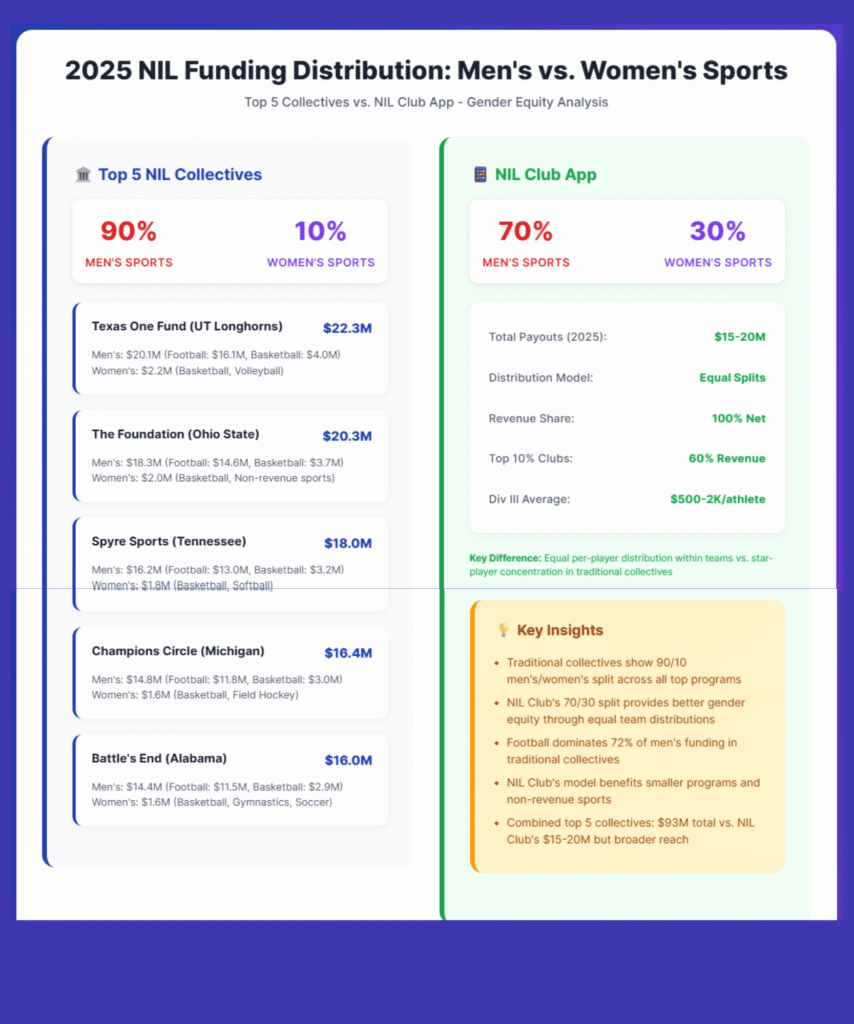You’ve probably heard about the tension between Title IX and NIL collectives.
Many of these groups have been criticized for giving more money to male athletes or players in high-revenue sports. That raises tough questions about fairness and compliance with Title IX, the federal law that bans sex discrimination in school athletics.
The NIL Club takes a different approach. Instead of paying players based on popularity or performance, it distributes revenue equally among all members of a team. Every athlete, no matter their sport or gender, gets the same share.
At first glance, that sounds fair. But does it actually solve the problems that have haunted traditional collectives? Let’s look closer at how this model compares and what it might mean for equity in college sports.
What Title IX Really Means in NIL
Title IX requires that schools treat male and female athletes equally in opportunities, benefits, and resources. It doesn’t mean everything must be identical, but it does mean both sides should have a fair shot.
In the NIL world, things get more complicated. Schools can’t directly control what independent collectives do, but when those groups are closely tied to athletic departments, their actions can still raise Title IX issues.
If one group of athletes, usually from men’s football or basketball, gets most of the money while female athletes get very little, that imbalance could be seen as a violation of the spirit of Title IX.
That’s why NIL Club’s equal share model is attracting attention. It’s a way to avoid those uneven outcomes by keeping the distribution simple and neutral.
How Traditional Collectives Create Inequality
Traditional NIL collectives often reward athletes based on their market value. The logic is simple: the bigger the name, the bigger the deal.
The problem is that men’s sports, especially football and basketball, bring in the most media attention and fan spending. That means women’s sports and smaller programs often get left behind.
Even if a collective doesn’t intend to discriminate, the outcome can still look unfair. When male athletes earn far more through NIL partnerships, it reinforces the same gap that Title IX was designed to prevent.
If a collective is closely linked to a university, that imbalance might even be viewed as part of the school’s financial system. In that case, the school could face scrutiny for allowing unequal treatment.
Why NIL Club’s Model Feels Different
NIL Club tries to remove all of that tension by paying everyone the same. Whether you play soccer, swim, or run track, you get an equal share of the revenue generated by your team’s page.
This approach has several strengths.
It’s Simple and Transparent
Everyone understands how it works. There’s no secret formula or negotiation behind closed doors.
It Treats Every Athlete Equally
Because every member receives the same amount, gender and sport no longer matter. It’s a clean way to prevent funding gaps from forming between men’s and women’s teams.
It Builds Team Unity
Instead of players competing for sponsorship money, they work together to grow their team’s fan base. That creates a sense of shared ownership and pride for both the fans and each player.
These benefits make NIL Club’s model feel both fair and modern. But even this system has a few challenges worth noting.
The Limits of Equal Distribution
Equal pay sounds perfect on paper, but it can create new questions.
Some athletes may argue that they bring more attention and value to the team, so they deserve more compensation. That’s a fair point from a business perspective, especially for players with strong personal brands.
There’s also a larger question about whether true equity means equal shares or fair outcomes. Title IX focuses on fairness, not sameness. In some cases, giving everyone the same cut might not address deeper gaps in exposure, funding, or opportunity between men’s and women’s sports.
Another consideration is whether Title IX even applies directly to NIL platforms. If NIL Club remains fully independent from schools and athletic departments, it may not fall under Title IX oversight. Still, if the goal is to promote fairness, its design clearly moves in the right direction.
Comparing the Two Models
To understand where NIL Club fits, let’s compare its system to traditional NIL collectives.
- Traditional collectives operate like private businesses, rewarding market value.
- NIL Club acts more like a co-op, giving everyone the same piece of the pie.

From a legal and ethical standpoint, that shift makes a big difference. The equal share model eliminates many of the conditions that could lead to gender bias, while also aligning with the values behind Title IX.
The NIL Club Ecosystem
NIL Club isn’t just a payment system. It’s a full community.
As of 2025, it serves more than 650,000 athletes across 20,000 teams, making it the largest NIL network in the country. Each athlete manages their own page, creates content, and interacts directly with fans.
The platform’s Brand Deals feature lets players see real offers and connect with companies that match their interests. Major brands like Amazon, SoFi, Gatorade, and Ulta Beauty have already tested campaigns through the platform.
What makes NIL Club stand out is that it combines two powerful tools. Fans can subscribe to their favorite athletes for exclusive content, and brands can sponsor teams or individuals directly. That mix creates opportunities for both engagement and income while keeping revenue distribution equal.
It works for small programs that rarely see sponsorship deals, and it still appeals to top athletes who want structure and consistency.
In short, NIL Club feels less like a corporate marketplace and more like a shared ecosystem where athletes have control over their own careers.
Does Equal Share Solve Title IX?
So does NIL Club’s model truly solve the equity problem?
It goes a long way. Equal distribution reduces gender-based gaps, simplifies the system, and helps protect against discrimination claims.
Still, it’s not a complete fix. True equality in college sports involves more than money. It also means equal access to facilities, media coverage, coaching, and long-term development opportunities.
The equal share model can’t fix all of that, but it does address one of the biggest and most visible issues: unequal financial support.
It’s a cleaner, fairer way to manage NIL revenue, and it sends a message that athletes across all sports deserve recognition and respect.

Conclusion: A Fairer Way Forward
The debate over Title IX and NIL isn’t going away anytime soon. As money continues to flow into college athletics, the pressure to keep things fair will only grow.
NIL Club’s equal-share revenue model offers a smart, practical step toward that goal. It gives athletes control, promotes equality across genders and sports, and removes many of the biases built into traditional collectives.
It may not solve every issue under Title IX, but it sets a new standard for fairness. It proves that equal opportunity and commercial success can exist side by side.
For schools, athletes, and brands trying to navigate this new landscape, NIL Club’s approach may not just be innovative. It may be the most balanced path forward.

